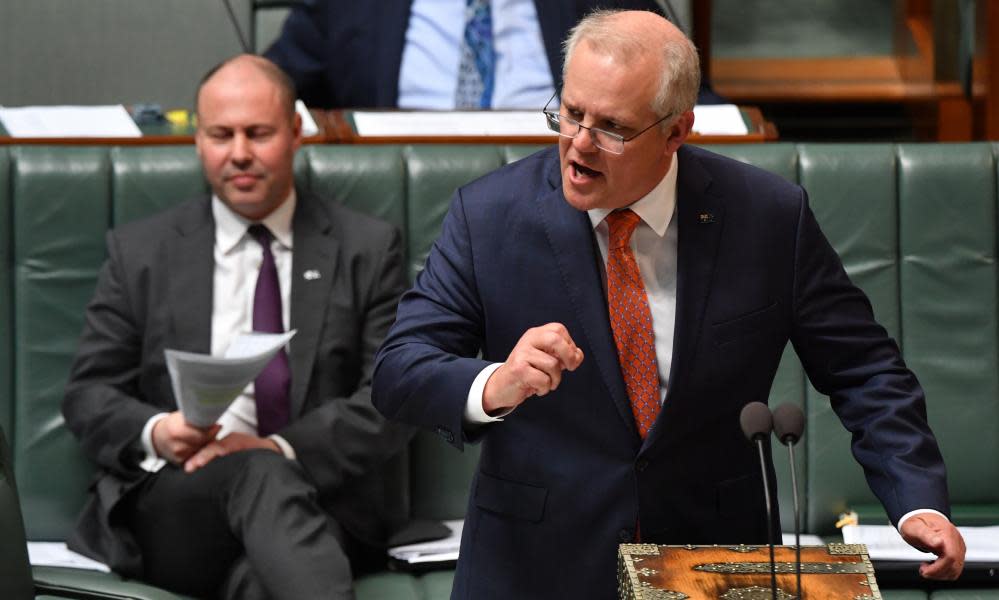The federal budget reveals an ideology that is set to kill any recovery just as it is getting started

As expected the budget was political and ideological and full of spin, but what its forecasts highlight is how it is also rather ineffective.
Budgets are incredibly detailed and packed with small statements and information that can either be minor and unimportant or massive in scale and import and yet just as easy to miss.
I spent most of my time on Tuesday looking at the tax cuts and economic predictions and by the time I looked up I had little sense of anything else that had occurred.
Related: Australian budget 2020: the six charts that matter for the post-Covid recovery | Greg Jericho
It means I missed aspects such as despite the arts agencies receiving a “Covid payment” the portfolio budget statements show that the National Gallery is getting a 12% funding cut, the National Museum 9%, and the Australian National Audit Office which investigated the sports rorts a 12% cut.
(The War Memorial meanwhile is getting an extra $16m and will increase staff by 12 – gotta love culture wars.)
More ideology was present by absence – the absence of an extension of the jobseeker bonus payments, or any mention of climate change other than in a footnote relating to “diplomacy”.
The budget papers are of course utterly riddled with spin.
For example 2017-18 was used as the base year for tax cuts which meant all figures included last year’s cuts. But nowhere was any table showing next year’s situation when the $1,080 low and middle income tax offset is removed.
Next year workers on between $45,000 and $90,000 will actually be getting a $1,080 tax rise. Enjoy!
For all the hope of a 'V shaped' recovery, by mid 2022, we will still be in a worse position than we were during the GFC
The budget also contained multiple assumptions which even the Treasury department seemed embarrassed to make.
For example it notes that “while a vaccine is assumed to be available from the end of 2021, it will take some time for complete global coverage. It will also take some time for the damage to household and business balance sheets and labour markets to be repaired”.
The very next sentence is “there is substantial uncertainty around the path to recovery.”
Ain’t that the truth.
The government also assumes that 2021-22 will see a big boom off the back of massive consumer spending and the housing construction.
This boom and low population growth means the budget predicts that GDP per capita will grow faster in 2021-22 than it has since the 1960s.
In 2023-24 company tax revenue apparently will jump from $67.2bn to $92.5bn – making it responsible for 57% of that year’s total tax revenue increase. Not bad for a tax that only accounts for around 20% of all tax gathered.
But it looks nice on the page and is set to occur after the next election so let’s not pretend there is any need to be realistic.
The budget also reveals just how committed the government remains to the idea that the private sector will save us.
Yes, they will spend a mass of money this year and the next, but it is not really to stimulate the economy.
Despite spending much more than occurred during the GFC, public sector demand is expected to grow by much less than it did then.
The government is spending money but its lack of real growth in investment (on, say, social housing or renewable energy) means it is not really delivering as much bang for its buck as occurred during the GFC.
In 2021-22 the budget predicts public sector demand will grow just 2.5% – the lowest since 2014-15, while somewhat laughably it assumes the private sector will grow by 7% – faster than occurred even during the mining boom or the 1990s recovery.
And yet all this recovery is not for much.
Graph not displaying properly? Click here
Just one sentence in the budget papers reveals how slow the recovery really will be.
It states “the employment to population ratio is expected to remain around 1½ percentage points below its March 2020 level in the June quarter 2022”
To give that some context, the GFC saw the employment to population ratio fall 1.35% points.
For all the hope of a “V shaped” recovery, by mid 2022, we will still be in a worse position than we were during the GFC.
And yet at that point the government will be massively reducing government spending and relying on the private sector as though things are going well!
This is not a budget that reveals a government which has changed its spots. Rather it is one that reveals its ideology is set to kill any recovery just as it is getting started.


